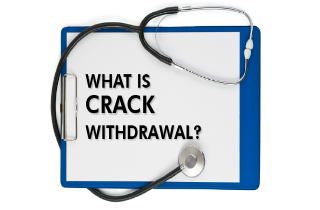Physical or mental dependence on crack develops very quickly ,as it is one of the most addictive forms of cocaine (itself a highly addictive recreational drug). Consequently, the withdrawal symptoms associated with crack can be as acute and include anxiety, depression, and terrible cravings.
Here, we look at what crack withdrawal and its symptoms are, as well as how long crack withdrawal lasts. Plus, we review how you can get through the withdrawal phase with the help of medications, home remedies and drug tapering. Then, we invite your questions about crack withdrawal or how to find crack addiction help at the end.
What is crack withdrawal syndrome?
In order to understand withdrawal, you first need to understand drug dependence. Physical dependence on a drug like crack occurs when the body becomes tolerant to a substance and needs the drug to function regularly.
Crack creates feelings, moods and sensations that one becomes used to – every sensation is heightened and amplified. These feelings become associated with the drug. Certain changes take place in the brain’s reward centers that make a person use the drug repeatedly and chronically. The sensitivity to the drug and number of receptors in the brain can decrease over time so that more and more of the drug is needed to create those feelings.
As the abuse continues, the brain produces less dopamine (a brain neurotransmitter that impacts feelings of pleasure). Then when a user stops their intake of the chemical substance the brain compensates in ways that will impair its normal functioning – memory, learning, cognitive functioning, judgment and decision making can all become impaired.
What is withdrawal from crack like?
Typically going off crack can produce extreme anxiety and restlessness and an acute craving for the drug. There could be mood swings, irritability, aggressive behavior, extreme fatigue, muscle pain and disturbed sleep as well.
What does crack withdrawal feel like?
The “high” from a crack hit is followed by the “crash” which is a feeling of overwhelming depression and even sadness or hopelessness. Some users experience physical pain, nausea, vomiting, shaking and so on while others experience mainly psychological symptoms such as extreme agitation, anger, exhaustion anhedonia (the inability to experience pleasure) and even suicidal thoughts.
A user will feel withdrawal symptoms when they go off crack. The severity and extent of crack’s withdrawal symptoms depend upon the length of time over which the individual has been abusing a drug and several other factors such as biology and genetics as well as environmental factors.
What helps crack withdrawal?
1. Detox – It can be tough staying off crack on your own because crack is so highly addictive and because the craving to use can be so overwhelming. This is why medical practitioners recommend voluntary supervised medical withdrawal from crack.
Detox incorporates three stages of (a) evaluation, (b) stabilization and (c) fostering patient readiness for treatment. Ideally, treatment will take into account individual and cultural backgrounds, personal vulnerabilities and strengths, sexual orientation and disability and will also try and involve family and other support systems.
2. Medications – Antidepressants and anticonvulsants medications (such as vigabatrin) ands dopaminergic and opioid antagonists or mixed agonists, can be used during crack withdrawal, depending upon individual circumstances.
3. Home remedies – Crack withdrawal places severe stress on an individual; both psychologically and physically. The severity of the withdrawal symptoms can be managed and controlled by self care. Specifically, home care for drug cravings includes:
- Understanding that your mind and body have grown used to this chemical substance and this is a natural reaction of the body to its absence
- Talking about it with a sober friend (an addict friend could be triggering and may enable addictive behaviors)
- Attending an NA meeting can be support recovery because it make you feel less isolated and helpless to know others are going though what you are
- Trying to create a safe and drug-free environment within the home and elsewhere by identifying and avoiding triggering people, places and situations
Questions about crack withdrawal
If you have any questions about crack withdrawal or how to treat crack addiction, use the comments section below. We’ll get back to you with the answers that you need.









Related Posts